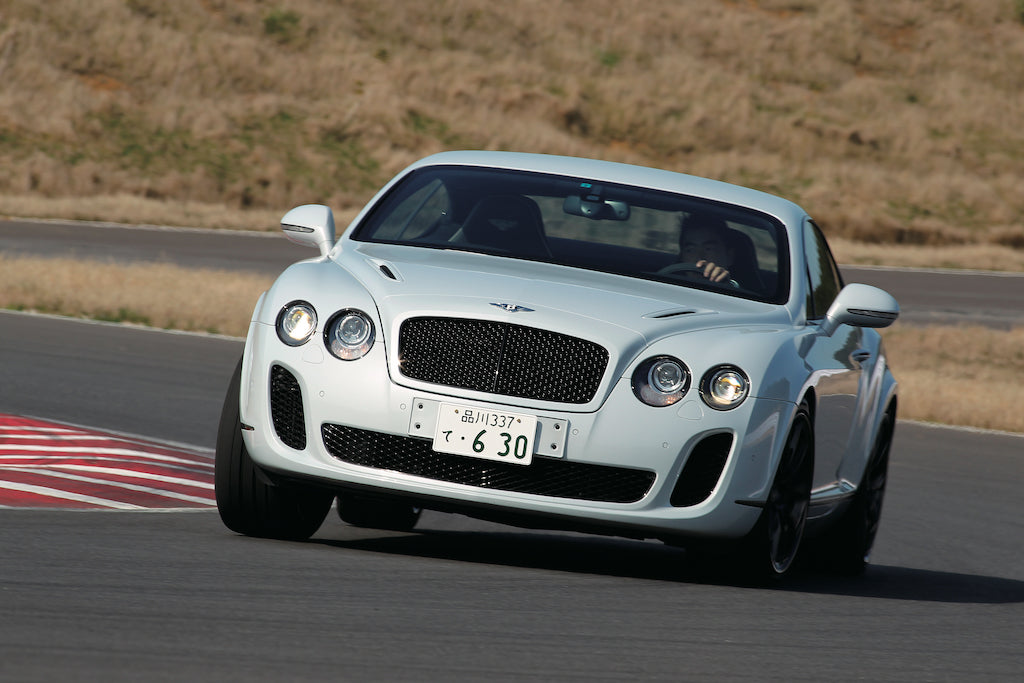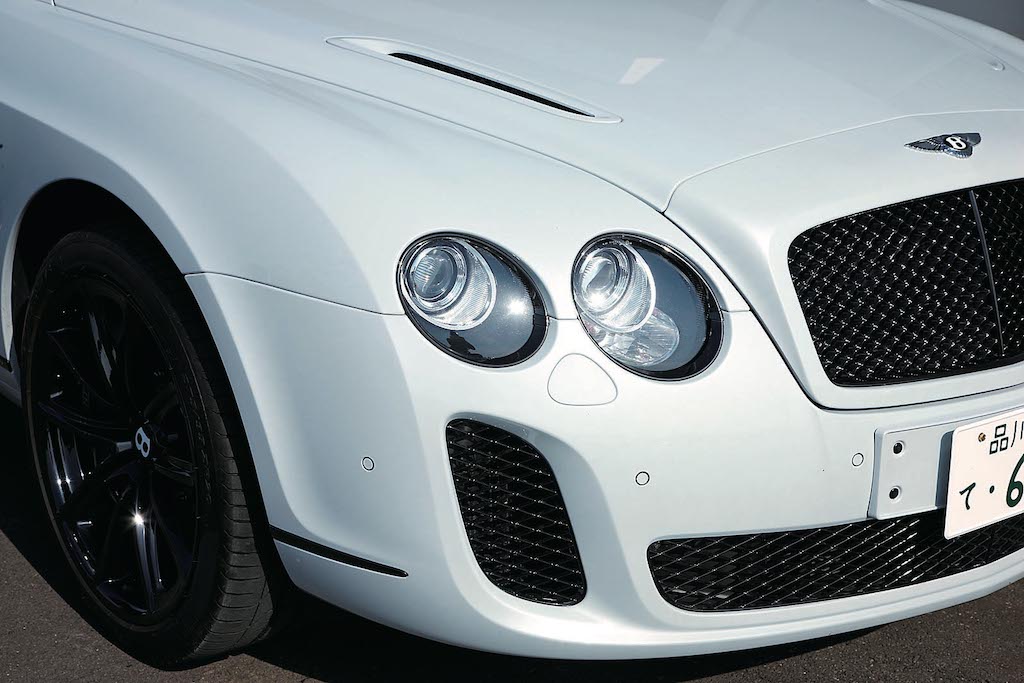
The Crewe-built Supercar
BENTLEY CONTINENTAL SUPERSPORT
Bentley's Monumental Achievement in both Performance and Environmental Features
A remarkable new addition has been made to the Bentley Continental range: Supersport. It is a modern, super-performance model that not only chases down elite performance, but has also been refined to be biofuel compatible and environmentally friendly. The opportunity to experience this Bentley masterpiece in Japan has arrived at last.
text: Masamichi Ishii
cooperation: Bentley Motors Japan
transration: Mako Ayabe and Michael Balderi

Let's do something extreme! This was the call to action resulting in the birth of the Continental Supersport. As a renowned manufacturer of high-performance sports cars, Bentley has made a name for itself in the world of motorsport, including the 24 Hours of Le Mans, so it comes as no surprise that the company is endlessly striving to reach new heights of performance.
The development of the Continental Supersport had a clear target: 'the fastest Bentley ever and the strongest Bentley ever'. The 0-100 km/h acceleration time, for instance, was to be under 4.0 seconds. Still, aiming for absolute speed in and of itself does not necessarily amount to 'something great'.
As an automotive manufacturer with a strong commitment to social responsibility, Bentley is devoted to minimising its impact on the local and global environment. The company's commitment is comprehensive and extends to the production process, including a 15% reduction in CO2 emissions for its products by 2012, the introduction of engines with 40% better fuel economy by 2012, and flex-fuel compatibility for all models by 2012. From among these goals, the Continental Supersport has already achieved flex-fuel compatibility. In addition to normal high-octane petrol, petrol blended with bioethanol can be used. The maximum mixing ratio is 85%. If the car runs on E85, an 85% bioethanol blend sold in North America and Europe, CO2 emissions can be reduced by up to 70%.
Not only is this the fastest and most powerful Bentley ever, it is also the greenest Bentley at the moment.

When the target is to become the ‘fastest ever’, it is a given that the engine will need to be strengthened. The 6.0-litre W12 twin-turbo in the Continental GT and Continental GT Speed has been boosted and computer-tuned to achieve a maximum output of 630 ps and maximum torque of 81.6 kg-m. This is arguably the most powerful Bentley ever, and certainly the most powerful set of specs on any Supersport in the world.
Mated to this is a ZF automatic (torque converter type) quick-shift transmission with 50% shorter shift times. The unit is considered sportier and more robust, with an ignition cut-off during upshifts, double gearshift (when downshifting from 5th to 3rd, for example), blipping mechanism and reinforced planetary gears.
In order to meet the dynamic performance targets, the focus shifted to weight reduction. Carbon ceramic brakes and lightweight wheels are standard. The interior, seats and chassis have also been trimmed to achieve an overall weight reduction of 110 kg. A particularly drastic step was converting the model into a two-seater.
The dynamic performance achieved by the synergy between high power and lower weight is 0-100 km/h acceleration in 3.9 seconds and a top speed of 329 km/h. Compare this with the Continental GT's 4.8 seconds and 318 km/h and the Continental GT Speed's 4.5 seconds and 326 km/h, and it soon becomes obvious that a peak of elite performance has been reached.
The chassis has also been modified, with the rear tread being 50 mm wider. The suspension features lightweight components, optimised shock absorber damping, improved anti-roll bar geometry and a tuned steering rack, as well as a 40:60 front-rear torque split, optimised ESP and second-generation carbon ceramic brakes.

When it came time to get behind the wheel, I was jittery with excitement at the thought of the model’s staggering performance, but I reassured myself that the 20ps increase over the Continental GT Speed, which I had test-driven previously, was nothing to fear.
In the world of 600-plus ps high-performance vehicles, 20 ps is only a fraction of a percent difference. But the Continental Supersport was far more than I'd imagined -- it was a whole new world.
The dash force is sharper from the very start, and there is something unique about the speed ride. The car also feels noticeably lighter. The effect of the quickshift transmission is more pronounced than you might expect: the time taken to shift gears has been reduced, and the force of the shift has been enhanced. Whereas the base A/T is as smooth as in any luxury car, so that it feels like a longer half-clutch on an M/T, the Continental Supersport accelerates with a light jolt.
It is quite literally sporty and compact. The brakes also provide a powerful deceleration G from the moment you place a foot on the pedal. Yet while it was direct, the pedal stroke was well-defined and seemed responsive to fine adjustments in pressure. The braking power and handling are flawless.
The outstanding feature is the cornering. Although the suspension was strengthened by 30%, the roll is clearly reduced, along with the weight. The grip is so high that one would expect the tyres were specially made, but they are the same as those on the base model. Perhaps not only the suspension but the mounting points themselves have been tuned. All movements are more direct, and the vibration transmitted from the road surface is richer. The rigidity of the steering is also noticeably high.
Ultimately, the Supersport is not only about ‘being faster’. Everything from the engine to the transmission, steering and suspension feels direct, with a quick response that gets the driver's adrenaline flowing. Before the test drive, I was somewhat wary of the vehicle’s performance, but my anxieties were quickly dispelled as I cleared a few corners. The drive and handling felt sharply manageable and confident, thanks, in large part, to the increased sense of unity between the driver and the vehicle.

The exterior design has undergone modifications to ensure high performance. In other words, function follows, and even becomes, form.
In particular, the cooling capacity has been increased to cope with the higher power output of the engine, and the air intakes have been enlarged to achieve this. The vertical grilles at both ends of the front lower section are now large vertical air intakes extending below the headlamps, and together with the main grille and front and lower bumper grilles, they let in a large volume of air. The engine is drained by twin bonnet vents. This generates negative pressure and allows positive air intake. The venting has been designed and engineered precisely to allow air to flow smoothly from the side mirrors along the body to the rear.
The grille and vents are finished in smoked steel for a sportier look. The headlamps are also colour-coordinated, with a black-finished case incorporating a smoked-steel bezel.
The side view features 10-spoke Supersport-specific wheels and a smoked steel finish around the windows and doors. The front wings feature exterior badges with the Supersport logo. This is actually the first time that Bentley has ever displayed the grade name on the body, a distinguishing mark of how unique the Supersport is.
The rear fenders are newly designed with a wider tread, but the body dimensions have remained unchanged. The wing mirrors have also been modified for the Supersport. Aerodynamics have been taken into account, but as mentioned, the main purpose is to rectify the air escaping from the bonnet vents in as clean a manner as possible.
The rear lip spoiler is raised by 8 mm at the tail end to increase downforce. Other special Supersport features around the rear of the vehicle include the lower valance of the bumper with a black finish, unique wide tailpipes and LED tail lamps with black-finished cases.
The interior feels light, with a sporty decor. The steering wheel and shift lever are made of soft leather that feels right in the hand and provides a solid grip. The fascia and centre console are finished in carbon fibre, replacing the conventional wood panels. The seating is a carbon fibre clamshell backrest with diamond-quilted Alcantara, which reduces the weight by 21 kg per seat. The rear seats have been removed and are fitted with carbon fibre crossbeams. Still, it’s worth noting that the rear seats are available as an option.
In addition to the standard shades of the Continental GT, four body colours are available: Ice and Quartzite as standard colours exclusive to the Supersport, and Dark Grey Satin and Light Grey Satin in matt paint as paid options.
■
What one looks for in a Bentley obviously varies according to personal preference, but if a true sporting feel is more important to you than luxury, the Continental Supersport is a must-try. If a two-seater is not for you, and you're concerned that adding a rear seat is a deal-stopper, rest assured that your fears are unfounded. Even if it does add a little weight, it's miles away - a world away, in fact - from the Continental GT and Continental GT Speed.






*This is a revised version of an article that appeared in Flying B No 004 (2010). The information provided here was accurate at the time of publication.

